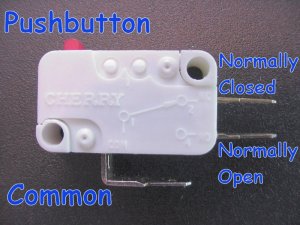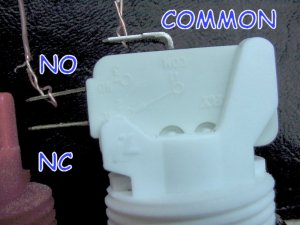|
Microswitch
without wiring
|

Click for a larger view
Click
here
for a large view without labels |
|
Microswitch
with wiring connected to pushbutton
|

Click for a larger view
Note
- I don't recommend using my wiring "twist it on" technique for your work!
:) |
|
The
microswitch type of switch is a bit more complicated. It has 3 contacts,
of which you will need to choose two to wire. The bottom connector
is the common contact. Then, instead of one "positive" connector
you have to choose between two of them -- NO (Normally Open) or NC (Normally
Closed). Read the next two paragraphs to explain that, or skip to
the last paragraph to see what this means to you.
NO means
the switch is normally open (i.e. the button is not pressed down
when it is not being used, or in simpler terms the button is "up" when
idle). To activate whatever the button's supposed to do, you press
the button, closing the switch. Closing the switch in turn
closes the circuit, allowing the electricity to flow and sending whatever
signal gets sent by the button.
NC is
the opposite of NO, meaning the switch is normally closed (i.e. the button
is
pressed down when it is not being used, or in simpler terms the button
is "down" when idle). To activate whatever the button's supposed
to do, you release the button, opening the switch. Opening
the switch in turn closes the circuit, allowing the electricity to flow
and sending whatever signal gets sent by the button.
Confused?
The short of it is this: Unless you're doing something out of the
ordinary, you'll want to connect wires to the "common" and "NO" contacts
(AKA "leads") of the switch. That way, the button won't do anything
until you press it, which is typically what you want. Take a look
at one of the microswitch buttons wired on my FrankenRig (test rig) over
on the left.
|
![]() Wiring
Wiring![]()
![]()
![]()
![]()
![]()
![]()